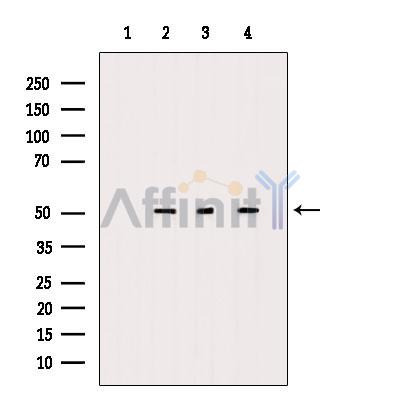C9orf72 Antibody - #DF12112
| Product: | C9orf72 Antibody |
| Catalog: | DF12112 |
| Description: | Rabbit polyclonal antibody to C9orf72 |
| Application: | WB IHC |
| Reactivity: | Human, Mouse, Rat |
| Prediction: | Pig, Sheep, Rabbit |
| Mol.Wt.: | 50-54 kDa,25-30 kDa; 54kD(Calculated). |
| Uniprot: | Q96LT7 |
| RRID: | AB_2844917 |
Related Downloads
Protocols
Product Info
*The optimal dilutions should be determined by the end user.
*Tips:
WB: For western blot detection of denatured protein samples. IHC: For immunohistochemical detection of paraffin sections (IHC-p) or frozen sections (IHC-f) of tissue samples. IF/ICC: For immunofluorescence detection of cell samples. ELISA(peptide): For ELISA detection of antigenic peptide.
Cite Format: Affinity Biosciences Cat# DF12112, RRID:AB_2844917.
Fold/Unfold
ALSFTD; C9orf72; chromosome 9 open reading frame 72; CI072_HUMAN; FTDALS; MGC23980; Protein C9orf72; RP11-27J8.2; Uncharacterized protein C9orf72;
Immunogens
Both isoforms are widely expressed, including kidney, lung, liver, heart, testis and several brain regions, such as cerebellum. Also expressed in the frontal cortex and in lymphoblasts (at protein level).
- Q96LT7 CI072_HUMAN:
- Protein BLAST With
- NCBI/
- ExPASy/
- Uniprot
MSTLCPPPSPAVAKTEIALSGKSPLLAATFAYWDNILGPRVRHIWAPKTEQVLLSDGEITFLANHTLNGEILRNAESGAIDVKFFVLSEKGVIIVSLIFDGNWNGDRSTYGLSIILPQTELSFYLPLHRVCVDRLTHIIRKGRIWMHKERQENVQKIILEGTERMEDQGQSIIPMLTGEVIPVMELLSSMKSHSVPEEIDIADTVLNDDDIGDSCHEGFLLNAISSHLQTCGCSVVVGSSAEKVNKIVRTLCLFLTPAERKCSRLCEAESSFKYESGLFVQGLLKDSTGSFVLPFRQVMYAPYPTTHIDVDVNTVKQMPPCHEHIYNQRRYMRSELTAFWRATSEEDMAQDTIIYTDESFTPDLNIFQDVLHRDTLVKAFLDQVFQLKPGLSLRSTFLAQFLLVLHRKALTLIKYIEDDTQKGKKPFKSLRNLKIDLDLTAEGDLNIIMALAEKIKPGLHSFIFGRPFYTSVQERDVLMTF
Predictions
Score>80(red) has high confidence and is suggested to be used for WB detection. *The prediction model is mainly based on the alignment of immunogen sequences, the results are for reference only, not as the basis of quality assurance.
High(score>80) Medium(80>score>50) Low(score<50) No confidence
PTMs - Q96LT7 As Substrate
| Site | PTM Type | Enzyme | Source |
|---|---|---|---|
| S9 | Phosphorylation | Uniprot | |
| K388 | Ubiquitination | Uniprot | |
| T440 | Phosphorylation | Uniprot |
Research Backgrounds
Component of the C9orf72-SMCR8 complex, a complex that has guanine nucleotide exchange factor (GEF) activity and regulates autophagy. In the complex, C9orf72 and SMCR8 probably constitute the catalytic subunits that promote the exchange of GDP to GTP, converting inactive GDP-bound RAB8A and RAB39B into their active GTP-bound form, thereby promoting autophagosome maturation. The C9orf72-SMCR8 complex also acts as a regulator of autophagy initiation by interacting with the ATG1/ULK1 kinase complex and modulating its protein kinase activity. Positively regulates initiation of autophagy by regulating the RAB1A-dependent trafficking of the ATG1/ULK1 kinase complex to the phagophore which leads to autophagosome formation. Acts as a regulator of mTORC1 signaling by promoting phosphorylation of mTORC1 substrates. Plays a role in endosomal trafficking. May be involved in regulating the maturation of phagosomes to lysosomes (By similarity). Regulates actin dynamics in motor neurons by inhibiting the GTP-binding activity of ARF6, leading to ARF6 inactivation. This reduces the activity of the LIMK1 and LIMK2 kinases which are responsible for phosphorylation and inactivation of cofilin, leading to cofilin activation. Positively regulates axon extension and axon growth cone size in spinal motor neurons. Plays a role within the hematopoietic system in restricting inflammation and the development of autoimmunity (By similarity).
Regulates stress granule assembly in response to cellular stress.
Does not play a role in regulation of stress granule assembly in response to cellular stress.
Nucleus. Cytoplasm. Cytoplasm>P-body. Cytoplasm>Stress granule. Endosome. Lysosome. Cytoplasmic vesicle>Autophagosome. Secreted. Cell projection>Axon. Cell projection>Growth cone. Perikaryon.
Note: Detected in the cytoplasm of neurons from brain tissue (PubMed:21944778). Detected in the nucleus in fibroblasts (PubMed:21944779). During corticogenesis, transitions from being predominantly cytoplasmic to a more even nucleocytoplasmic distribution (By similarity).
Perikaryon. Cell projection>Dendrite.
Note: Expressed diffusely throughout the cytoplasm and dendritic processes of cerebellar Purkinje cells. Also expressed diffusely throughout the cytoplasm of spinal motor neurons.
Nucleus membrane>Peripheral membrane protein. Nucleus.
Note: Detected at the nuclear membrane of cerebellar Purkinje cells and spinal motor neurons. Also shows diffuse nuclear expression in spinal motor neurons.
Both isoforms are widely expressed, including kidney, lung, liver, heart, testis and several brain regions, such as cerebellum. Also expressed in the frontal cortex and in lymphoblasts (at protein level).
Interacts with SMCR8; the interaction is direct. Component of the C9orf72-SMCR8 complex, at least composed of C9orf72, SMCR8 and WDR41. The C9orf72-SMCR8 complex associates with the ATG1/ULK1 kinase complex. Interacts with ATG1/ULK1 kinase complex members ULK1, ATG13 and RB1CC1. Interacts with HNRNPA1, HNRNPA2B1 and UBQLN2. Interacts with small Rab GTPase RAB1A; the interaction mediates recruitment of RAB1A to the ATG1/ULK1 kinase complex. Also interacts with small Rab GTPase RAB7A (By similarity). Interacts with cofilin. Interacts with GTP-binding proteins ARF1 and ARF6 (By similarity).
Restrictive clause
Affinity Biosciences tests all products strictly. Citations are provided as a resource for additional applications that have not been validated by Affinity Biosciences. Please choose the appropriate format for each application and consult Materials and Methods sections for additional details about the use of any product in these publications.
For Research Use Only.
Not for use in diagnostic or therapeutic procedures. Not for resale. Not for distribution without written consent. Affinity Biosciences will not be held responsible for patent infringement or other violations that may occur with the use of our products. Affinity Biosciences, Affinity Biosciences Logo and all other trademarks are the property of Affinity Biosciences LTD.







